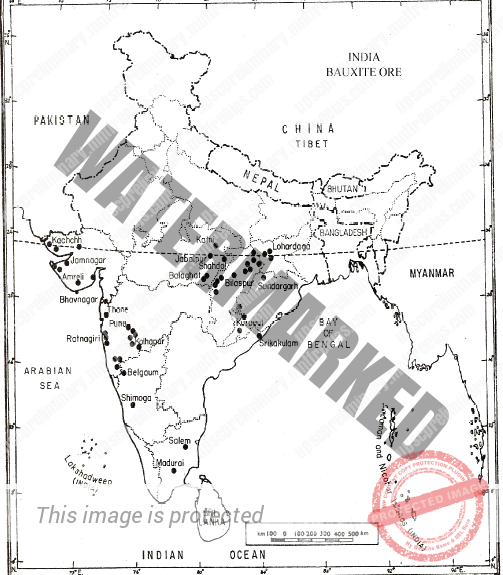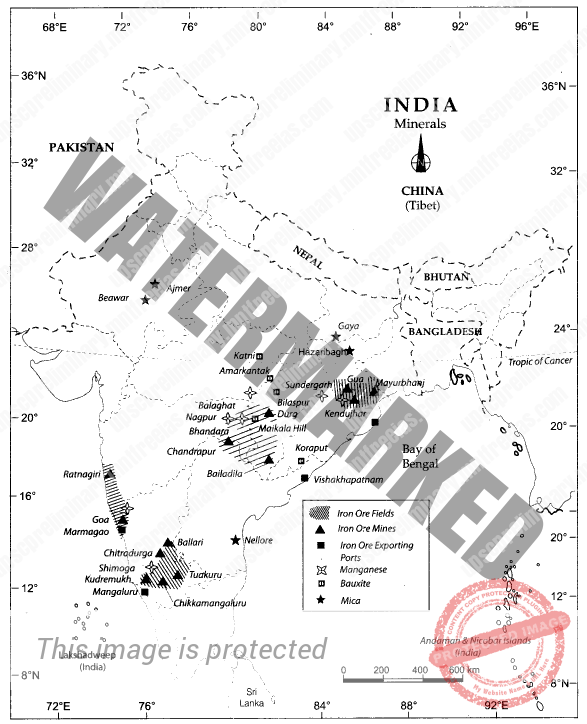- DEVELOPMENT OF MINERAL AND ENERGY RESOURCES
- NON METALLIC MINERALS
UNIT 6 – MINERALS AND RESOURCES – PART 5
DEVELOPMENT OF MINERAL AND ENERGY RESOURCES
Distribution of Bauxite
Australia is the largest producer of Bauxite followed by China. India stands 5th at world level. India’s bauxite production in 2016 was around 22.08 million tonnes.
Odisha is the top producer (60%) of Bauxite in India. The main bauxite belt is in Kalahandi and Koraput district and extends further into Andhra Pradesh. Also, major reserves occur in Jharkhand, Maharashtra, Madhya Pradesh, Chhattisgarh, Gujarat, Karnataka, Tamil Nadu, Goa and Uttar Pradesh.
(ii) Copper:
Being a soft metal coppers used extensively in metallurgical Industry, making utensils and coins. Being a good conductor of electricity and ductility, it is extensively used in a vast variety of electrical machinery, wires and cables. 76% of the world’s copper extracted from pyrite ore. Copper is highly lustier and acts as good conductor which makes it desirable in electrical industries.
Distribution of Copper:
Chile leads in production of copper worldwide followed by Peru. India accounts for only 0.15% of the world’s production.
Madhya Pradesh is the single largest copper producing state in India. Major copper ore deposits are located in Singhbhum district of Jharkhand, Balaghat district of Madhya Pradesh and Jhunjhunu and Alwar districts of Rajasthan
Non-metallic Minerals
Non-metallic minerals are mineral that do not contains metals. A large number of non-metallic minerals are found in India but only a few of these are commercially important. They are limestone, dolomite, mica, gypsum and phosphate. These minerals are used in a variety of industries such as cement, fertilizers, refractories, and electrical goods.
(i) Mica
Mica has multi layered structures made up of thin sheets. It is light weight, flexible and strong. Also, it can withstand high temperatures high voltages. Mica is known for its better insulating capacity. India is the leading producer in sheet mica. It was one of the indispensable minerals used in electrical and electronic industries till recently. However, its synthetic substitute has reduced our exports as well as production considerably.
Distribution of Mica
India is the largest producer of mica in the world. It accounts for 60% of world’s total production. Mica mining in India was mainly done for export. The principal importing country was the U.S.A. which took about 50 percent of the imports.
In India mica deposits occur in three principal belts. They are in the states of Andhra Pradesh, Jharkhand, Bihar and Rajasthan. Bihar and Jharkhand produce the high-quality ruby mica. These state supplies more than 80% of the India’s output. In Jharkhand Mica mines found in Giridih and Koderma districts of the state. In Andhra Pradesh mica is found in a belt in Nellore district. Rajasthan is the third largest mica producing belt. Rajasthan’s Ajmer is major producing region of Mica. Other zones, covers the districts of Jaipur, Udaipur, Bhilwara, and Kishangarh. But in these regions quality of mica is inferior.
(ii) Limestone
It is formed in sedimentary rocks of most geological formations, and it is essential for cement Industry and smelting Iron ore. Limestone is used in a wide range of industries. 76 % of the country’s total consumption is used in cement industry, 16% in iron and steel industry and 4% in chemical industries. The remaining 4 % is used by sugar, paper, fertilisers and ferromanganese industries. Limestone with high silica content is preferred in cement industry.
Distribution of limestone:
Madhya Pradesh possesses 16 % of the total reserves. Other major producing states are Chhattisgarh, Andhra Pradesh, Gujarat, Rajasthan, Karnataka, Tamil Nadu, Maharashtra, Himachal Pradesh, Orissa, Bihar, Jharkhand, Uttarakhand and Uttar Pradesh. The remaining part comes from Assam, Haryana, Jammu & Kashmir, Kerala, and Meghalaya. Karnataka contributes about 10 percent of the total reserves.
Precious Minerals:
These are rare naturally occurring chemical elements (Metallic) of high economic value. Precious metals are less reactive. E.g.: Gold, Platinum, Diamond, etc. India is the top consumer of Gold.


